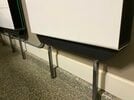An easy solution would be to mount 3/4" plywood to the studs, screws every 12". Then mount the PWs to that. You should be fine. If you are still concerned, you could mount the plywood larger than the PWs, say to one extra stud on either side, which will give you that much more stability. Living in CA, I expect I will need something more robust since the ground likes to wiggle out here!
I really like the jist of your idea.
Strictly speaking, screws are usually not rated for as much sheer as nails; some screws are specified for more sheer than others, so check the specs (in construction class, the saying is that "screws are not sheer rated", which strictly speaking is often false). This might be a good reason to either use nails (which are usually quite a bit cheaper) or get better spec screws. If you look for the more pricey screws, you can find sheer rated ones in even big box stores like Home Depot, Lowes, and you can even find some that are exterior rated too (yes, read the specs, often posted on the back of the box they come in for the more expensive ones, or sometimes requiring you to search for and download a manufacturer PDF and compare product ID's (ugh)). They usually have a different head than Phillips, so be sure to get an extra tip for that screw type. Lag screws, as another poster mentioned, would do it pretty well, but don't forget to predrill so you don't ruin your studs; lag screws are almost overkill, but better than regular screws to be sure (and are the most expensive option with the most installation trouble). I really like your idea of putting up that 3/4" plywood: it would make the whole room a bit less prone to falling over in an earthquake. I suppose a zillion non-sheer rated screws would work, but just to be on the safe side, I recommend you get the sheer rating of the screws and calculate it with plenty of headroom. Done right, the screws end up being a substantial portion of the plywood cost. That's why some would use nails, most angled a bit down to hold the plywood up, and quite a few at other angles to keep it from wandering off the wall (be sure to aim toward the meat of the stud for the ones nailed in sideways, i.e., plot the trajectory, and realize you would start the puncture quite a distance from the stud line).
Having said all that, it wouldn't be a horrible idea to synchronize the mounting brackets for the Powerwalls with the studs too, for added strength, even with the plywood.
BTW sheer is cross-force; e.g., imagine a screw horizontally screwed into a stud; the sheer force would be vertical. If the screw were vertical, the sheer would be horizontal.
This brings up an interesting topic of friction: the screw holds the item tight against another item, and the friction holds the items, allowing some sheer strength, but if the items ever became apart (loose with respect to each other) (something that probably happens exactly when you most need sheer strength), that benefit is lost. So that's why people like me don't like to depend on this friction principle.
Everything I said presuposes you actually know exactly where the studs are. Maybe under the plywood area you could knife out a couple strips of drywall so you can find the studs and map them out (remember they may not all be straight or plumb (vertical)); then put the strips back with a few drywall nails/screws and a little drywall filler compound to keep the fire rating good. Or look for the existing nails/screws to estimate for yourself (magnets sometimes work). Or use a stud finder.





